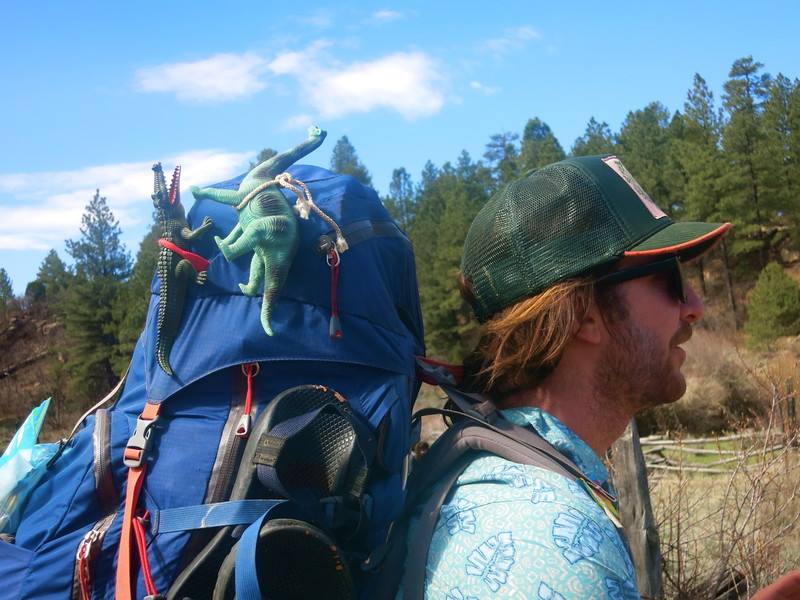
Walking through the icky sticky mud and the sinking sand dunes of the Dirty Devil River, one can take a trip through time. When I’m not busy falling into riverbed holes and avoiding treacherous quicksand, I can look to either side of the canyon and read the story of time. We look up to the towering walls and see ripple marks in rock which mirror the same ripples washed into the mud of the riverbanks today. Using the principle of uniformitarianism, we assume that the same forces that shape the mud today, resulted in the same shapes we find in rock more than 200 million years old. Naturalists like John Muir have used this approach to analyze glaciation in Yosemite Valley. Modern day geologists do so as well. With this tool, I am reading the stories of ancient water systems, sand dunes, and impressions of footprints laid down in these canyons millions of years ago.
Today the only water we see in the Dirty Devil Canyon is mostly in the main river channel. The Kayenta Formation however tells a different story. Within this layer of 200 million year old rock I see a sequence of ripple marks. Throughout the cliff faces there are varying sized smiley face lines, which interrupt the uniform planar striations that run along the rock face. These smiley faces are more formally identified as “channel lenses.” They show the approximate width of ancient rivers that once spread all across the land. On each side of the smile there would have been a riverbank, at the bottom of the smile, a river channel. These watermarks and smiley faces in stone look identical to the markings in the mud and riverbanks I see today. Other layers, like the Navajo Sandstone, tell a different story.
One thing you cannot ignore when travelling the Colorado Plateau is the extremely varied weather pattern. In the morning it’s so cold I find it difficult to make my fingers function properly; afternoon has you hunting for any bit of shade. One day in particular we had hiked many miles in the dry heat of the afternoon and then got bombarded by a hailstorm and flash flood by the time we reached camp. Has this area always been so variable? If I’m not sinking in mud I’m sinking into small sand dunes and once I get a moment to look up from breaking trail, the Navajo Sandstone tells me this is nothing new to the Colorado Plateau.
Long angled lines striking across the face of the stones look just like the wind swept sides of the sand I walk on. The only difference lies in size, the lines on the rock layer are much larger. In geologic terms these lines are known as “cross bedding.” With uniformitarianism I can infer these lines are telling stories of large sand dunes. Indeed geologists believe the Navajo layer constituted the largest sand dune desert known in Earth’s history! Cross bedding can even tell us the direction of the wind that shaped these dunes.
Now I know the land was once muddy and then became sandy. What can I see now because of this change in landscape? Between two other rock layers, one made of lithified mud and the other sand, a massive chunk has fallen from the canyon wall allowing me to gaze over one hundred little footprints of the dinosaur known as Grallator!
Some of my earliest childhood memories are of playing with my large collection of dinosaur toys. Now on the Dirty Devil River it seems they have left something for me, rekindling my curiosity and childlike wonder. Seeing these footprints in sediment that is over 230 million years old has to be one of the most rad things I’ve ever laid my eyes on!
Just as I walked through the mud along the riverbanks and make a footprint, I realize it could be fossilized in the same way under the proper conditions. I have an idea about the land Grallator and his friends walked through. I wonder what their groups of buddies were doing in the mud before the impressions were suddenly filled in by sand and lithified under the heavy weight of mounting sediment?
***
The experience of trading my normal box shaped classroom for the meandering river and steep colorful canyon walls has been an amazing decision. Being able to walk through a landscape and hypothesize what happened in the past based on the processes you notice today absolutely fascinates me. With experiential learning and actively asking questions about my observations, I am able to clearly understand in what ways this landscape has developed as well as how these mechanisms cause and repeat this change. Let the story of time continue as I venture on through the Colorado Plateau.